29th October 2007 - 'Plant Blindness' - why do some people not see plants?
Something was mentioned to me by a friend the other day that has been rumbling in the back of my mind for some time, though in a vague sort of way; it was her use of the term ‘plant blindness’ that brought it to the forefront and gave it a name. ‘Plant Blindness’ describes the state of mind of many people in modern society, where they fail to notice plants, cannot name those they do see and do not recognise their importance to our world.
"Plants are often seen as simply ‘things’, they are inert, decorative, they don’t ‘do’ anything"
Another friend told me of taking a nephew for a walk in the woods one fine spring day; all around was fresh green growth and the first flowers of spring after a long winter. It dazzled the eye with its vitality and John thought the boy would be as entranced as he was himself. The nephew didn’t like it, though, and wanted to go back home because, he said, it was ‘boring’.
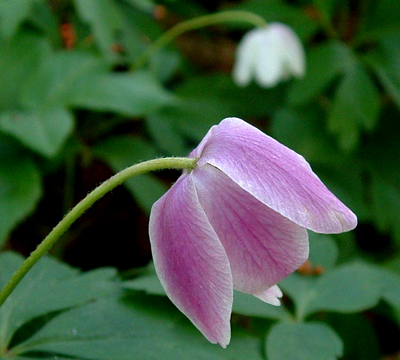
Wood Anemone, one of the first flowers of spring
What, I wonder, could have been added to the picture that would have made it interesting? Animals, perhaps? Possibly not birds as they are small and move so fast – they are often out of sight within seconds of you spotting them. No, birds are too common anyway, you can see them every day, even in a supermarket car park. Adding mammals to a woodland scene might seize the attention. A stately deer raising its head in alertness; rabbits grazing in a field; a fox quartering a meadow; badgers at sunset. These are all creatures we don’t often see so we find it exciting when we do, but remove them and the picture, for some, loses interest.
How can this be? What has happened in our society when someone can be surrounded by burgeoning growth and fail to notice, not just the beauty but also the importance of all that life. They are vital to survival, but plants are often seen as simply ‘things’, they are inert, decorative, they don’t ‘do’ anything.
Compare them to the latest video game and maybe they do appear dull. After all, look at all that green and brown – small flowers, too, in general - it may seem insignificant to eyes that have been fed on vibrant colours and constant movement since early childhood. Where is the contest between pitting your wits in the latest game and kneeling down to see the intricate patterns on a woodland flower? One is active, full of challenge and adrenaline, whilst the other, in comparison, seems too passive to be bothered with.
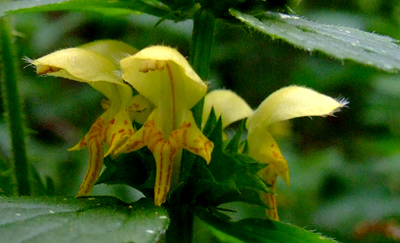
Close up - the intricate patterns on a Yellow Archangel flower
So, what causes Plant Blindness? How can there be such fervent significance given to manufactured objects and virtual worlds, and at the same time apparent apathy for the natural world? I don’t mean rare orchids or strange creatures at the bottom of the ocean, even the sky is a wondrous and constantly changing light show. I wonder if personal control is part of it – in our homes, to a large extent, we control the environment; we choose the lighting, colours and furnishings, we choose what movement will entertain us on the screen and, if we’re lucky enough, we set the temperature and humidity levels to those that we find most comfortable.
Compare that with, say, 300 acres of woodland. You can’t set the temperature, you can’t turn off the rain or adjust the light and, in terms of furnishings (i.e. growth), the area is too big to be controlled by you alone. Does that mean it is more likely to be disregarded?
Look, then, at the municipal planting put in place instead of the natural environment. There, we see the other extreme – all is order and neatness. You’ll find blocks of vibrant colour – those wretched Busy Lizzies will in there again, how I hate them still – bright yellow, red, pink, blue and white, all laid out in a geometric pattern with ruler precision. Someone will have sat down and carefully figured out the pattern, colour scheme and the exact number of plants required. Kudos to them for doing it but, on the whole, it not only looks ugly and uninspiring, but completely unnatural.
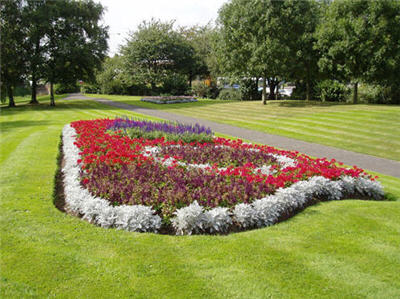
Municipal planting
Some of these schemes are clever, but I cannot but think that they appeal to only a few. Their orderliness requires our restraint as we pass by and the carefully clipped, perfectly green lawns only add to that affect. I have long wondered if that is one reason why municipal planting schemes such as this are vandalised by young people, appalled at the regimentation, the implied instruction to obey, who feel the need rebel and so destroy it.
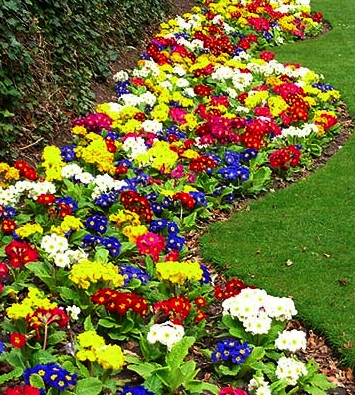
Inspired?
Is there a happy medium? There must be some way to bring people closer to a more natural environment that will allow them to actually see the plants around them, to feel their link to nature when it is close to home and, thereafter, see beauty in the chaos of wilder places which are further away. One word I have seen used is ‘ownership’ – when people feel a link with a place, they will care about it more and be less likely to throw down their litter, or trash the place, because it feels like theirs.
Are we destined to live in a world made up of ignored woodland and destroyed parks? What a thoroughly depressing idea that is. Surely, it cannot be borne. Then, I see hints, here and there, that ways can be found to encourage plant visibility rather than blindness.
The Woodland Trust have done great work in this area through their Phenology project, now called Nature’s Calendar. By encouraging people of all ages, but especially in schools, they ask people to go out in spring and autumn to record the changes they see in plants growing in their area. When does the first bluebell open? When is the first bumblebee seen? What date was the first cuckoo heard?
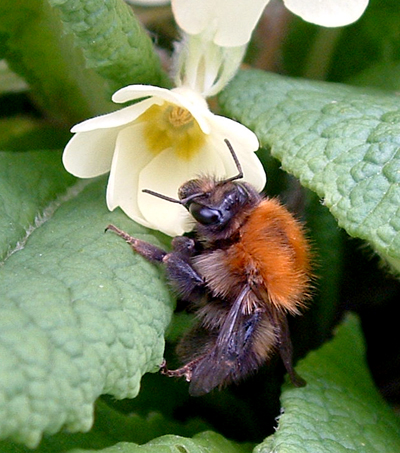
Early bumblebee foraging on a primrose
There are many trees, flowers, fruits, birds and insects to look at and results can be recorded on the website, so that a broad picture of events from spring and autumn appears. You can check the results from one year to another, either in your area or nationally, to see what the differences have been. Some 150,000 now send in results from all over the UK, which builds up a pretty good picture of what is happening in our countryside and gardens. Also provided are ideas for learning, activity packs for children and teachers, as well as regular challenges and competitions. If our children are knowledgeable about the natural world about them, it will always hold interest and should never be boring. Hopefully, they will remember and pass on the interest and knowledge to their own children.
Closer to home, the work of Piet Oudolf and Noel Kingsbury, amongst others, is inspirational. They design with naturalistic planting – a combination of perennials and grasses – which is as beautiful in life as it is in death, though the ‘death’ part is an illusion since, as perennials, the plants come back in spring. The Lurie Garden, part of the Chicago’s Millennium Park, is an excellent example of naturalistic planting. Surrounded by skyscrapers, it is an oasis of colour, movement and life, a flower-filled prairie in the middle of the city.
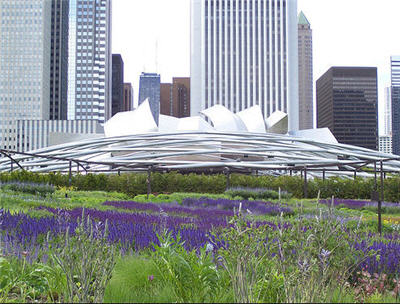
Lurie Garden, Chicago.
People seem to be comfortable here and I have a notion about environments like this; they bridge the gap between the necessary order of a city and the relative chaos of woodlands and the wild. As a test, I searched on ‘Lurie garden vandalism’ and nothing came up. I wonder if the apparent lack of order in the planting, gives many people something they need in terms of a link with nature. There is no lack of order, of course, but the way that the plants blend into each other can make it look that way.
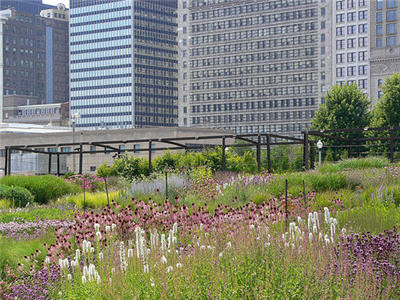
Lurie Garden, Chicago
Creating gardens like the Lurie Garden takes care and knowledge; there is far more to it than setting out a certain number of annuals in a neat geometric pattern. It seems almost chaotic, but the end result does not jar the senses - it is lovely to look at, can last for years, rather than one season, attracts wildlife and needs less maintenance and watering.
The gardens at Goltho House, just outside Wragby, near Lincoln, are also planted in a naturalistic style and look especially fine in autumn, when the grasses and foliage take on yellow and orange hues. As the year progresses, the colours fade to buffs and dark browns, which sets off the hoar frost perfectly.
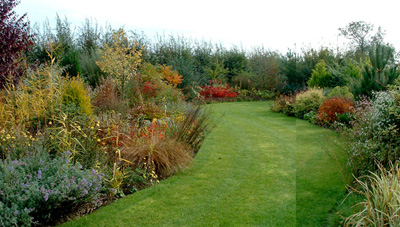
At Goltho House, October 2004
Still close to the urban centre is the Guerilla Gardening movement, where people of all ages gather in groups, or singly, to care for neglected areas in their communities. ‘Illicit cultivation, they call it, because the land is often council-owned. Areas chosen are such places as outside blocks of flats or at road sides and they are generally in poor condition, full of weeds and litter. The Guerillas come along, often at night, dig up the weeds, clear away the rubbish and put plants in. Guerilla Gardening also encourages feelings of ownership and those who carry out the gardening report that some digs are subsequently cared for by others, as well as those who planted them.
One of the things I like about Guerilla Gardening is that it gives people in run-down urban areas a sense of control, because it is they who make the changes and not some faceless official in an orange jacket, who comes along once every three months to strim the grass and crisp packets.
I cannot help but think that, given the opportunity to take control, many more people would be encouraged to see plants as real living things and necessary part of our environment, not just blobs and scraps of colour that barely register in their peripheral vision.
Combine the watching of the seasons, naturalistic planting and Guerilla Gardening, spread the word of all three, and it would be interesting to see what happened. I live in hope.
© Copyright Miranda Hodgson 2007